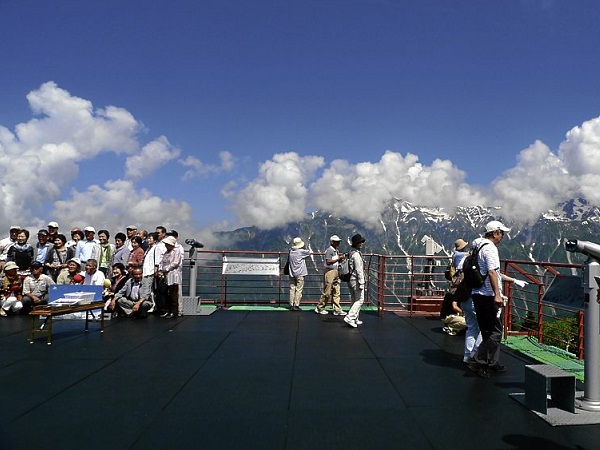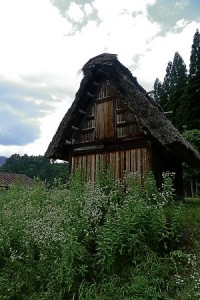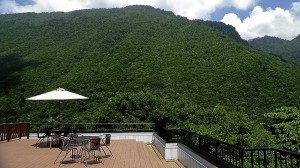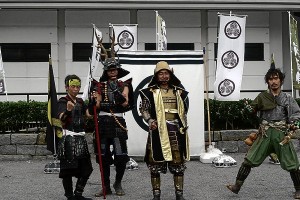
Most of the stories I’ve heard about Japan were about Tokyo and Osaka, which my dad frequents. But, as part of Delta Airlines’ familiarization tour of Nagoya and the prefectures of central Japan, I was able to experience the quainter side of Japan, replete with verdant greens as far as the eye could see, and beautifully preserved alongside the wide, concrete highways and swift trains.
At Shirakawa-go, just a little past Takayama, lies a historic village, a Unesco World Heritage site, known for its thatched roofs made of straw grass. Though the material is thinner than bamboo, the roofs are strong and sturdy enough to withstand heavy snowfall in winter.

Visitors are encouraged to visit during winter, when the snow blanketing the roofs and the twinkling lights make for a beautiful sight, almost as if you were walking into a snow globe.
While the village is well-preserved, it is also a residential area for roughly 1,800 people, with pension houses available for tourists who like to stay a bit and experience how it is to live in a gassho-zukuri (“prayer-hands” roof construction) style house.
‘Onsen’
After our village tour, we headed east to stay the night in Yakushi-no-yu, a Japanese-style hotel (no beds, only a futon laid out on a tatami floor) known for its huge “onsen” (hot springs). The onsen is very popular among the Japanese.
Because Japan’s geography is filled with rivers, mountains and an active volcano, the onsen is also a widespread fixture all over the country.

The location of Yakushi-no-yu allows its hot springs to have water straight from the mountains and the river. The waters are known for their curative properties (visitors are even encouraged to drink the water). If you plan to spend a couple of nights here, make sure to bring home bottles of the mineral water spray, which helps refresh and soften the skin.
Shinhotaka Ropeway
From experiencing the water from underneath, you can also experience the air from up high via the Shinhotaka Ropeway. The 42-year-old lift is also known as the only system in Japan to have a double-decker gondola.
The steep 2,156-meter ascent will take you to the spectacular Observation Deck, which offers a 360-degrees view of the snow-capped mountains. The view is so awesome that it has earned a two-star rating in the Michelin Green Guide Japon.
The Ropeway is operational throughout Japan’s four seasons, so you can check out the view whenever you’re there (make sure to check the weather reports for fog-free days, though). Before going up the stairs to the deck, make sure to stop by the souvenir shop and get some postcards you can send family and friends back home (the deck has a bright red mailbox for you to drop off your postcards).

From the Shinhotaka Ropeway, we took a side trip to the Nakao Kougen Hotel, a small boutique hotel tucked in among the mountain view. The hotel has an outdoor dining deck overlooking the mountains. It’s an ideal secluded spot for honeymooners or those looking for a quiet respite.
Takayama
Takayama, where we stayed next, is home to Hida beef and a special type of ramen noodles, which are thinner and absorbs more broth flavor, allowing for a clean-tasting, comforting bowl of ramen.
Hida beef, which has perfect marbling and great texture, is a contender for the more popular Kobe beef. Enjoy the beef on its own, which you can grill on a small skillet on your table or enjoy on a hot pot with vegetables and noodles. All you need is a little sprinkle of salt to bring out the exquisite flavor of the beef. This was really one of the trip’s highlights, along with fresh, creamy yogurt from Hida’s cows.
Gujo City
Heading down south, we stopped at Gujo with its clean waterways. Swimming along the canals are huge, fat carp, and along those waterways are boxes where you can drop a coin and receive a packet of fish food to feed the hungry, eager fish (I’ve never seen fish act like hyper puppies jumping out from the water).

The attractions of Gujo are very kid-friendly, from the food replica factory to the dinosaur park, where kids can interact with robotic dinosaurs (think Jurassic Park, but you won’t get eaten). Japanese curry lovers can enjoy Gujo’s version of the curry with its specialty wild boar croquette, paired with thick slices of fresh Gujo ham.
Inuyama City
Located further south is Inuyama City, home to the oldest wooden castle in Japan. The climb up the four-story castle is very steep, but the view from the top is worth it (make sure to put your camera on panoramic mode). Architecture buffs will marvel at how the stone walls were made and how they’ve survived, given that no bonding material was used. The stones were simply stacked together like a puzzle.
Also located in Inuyama is the Meiji-mura museum, where 60 buildings from the original Meiji period were brought and restored. Here you can see how East met West via houses with an obvious Western influence. Another treat for architecture lovers, the museum is home to the reconstructed Imperial hotel main lobby (originally from Tokyo), which was designed by Frank Lloyd Wright.
Gamagori

As we made our way back to Nagoya, our last stop was Gamagori, located along the coast of Mikawa Bay, which opens up to the Pacific Ocean. Gamagori is a seaside town with hotels overlooking the gorgeous bay that offer water activities such as sailing.
Lagunasia is also a kid-friendly place to visit, as it is the location of a Naruto theme park. The city is also known for its fruits, particularly oranges. Spend an idyllic day exploring the coast and heading to Gamagori fruit park, where you can experience plucking your own fruit from the bushes; it doesn’t get any fresher than that.
Enjoy fresh seafood and lobster for dinner (prepared cooked or raw). We ended our Gamagori visit at Okazaki castle, where we watched a live reenactment of a battle between shogun warriors (a treat kids will love!).
The castle is also home to the Tokugawa Shogun museum, where intricate automated dioramas illustrating the battles of eras gone by are on display. You can also dress up like a shogun by the costume area, complete with weaponry for an authentic experience.
Back in Nagoya
We ended our Chubu tour back at Nagoya, where we still had time to visit the Nagoya TV tower, to see the city in its full glory as well as do some shopping at the department stores. Car enthusiasts will want to see the Toyota Automobile Museum, a vital part of Japanese history.
Though we had five whole days to explore Chubu, central Japan is so vast that you can come back year after year only to find something new to discover.
It may have been my first time to visit, but I realize now that all the stories about Japan and its beauty were not an exaggeration. They are truly something else. All it takes is one visit to make you fall in love and become a frequent visitor.
Getting There
1. Fly Delta
If you want to explore Japan thoroughly, take Delta Airlines, which flies to both Nagoya and Narita, so it’s very easy to land in Nagoya and explore central Japan. Once you’ve had your fill of nature, you can hop on the Shinkansen, Japan’s bullet train (an experience in itself), and arrive in Tokyo. Stay there a few nights and then fly back home via Narita Airport.
Delta’s converted Business Class Elite section now has full-recline flatbed seats with special meals designed by Top Chef regular guest judge Michelle Bernstein. Economy Class gets a boost, too, with selected Economy Comfort seats featuring more legroom, more recline and early boarding.
It was my first time to fly with Delta via the new Business Class seats and I really loved the experience. The flight attendants were warm and attentive, the food was great and the in-flight entertainment was so good I didn’t even bring out my iPad.
Those on long-haul flights need not worry about running out of gadget juice. Delta’s seats are equipped with chargers (this alone made me love them), and some long-haul flights even offer in-flight Wi-Fi! The flatbed seat coupled with the great entertainment selection made me feel like I was in a cozy cocoon. It was my first time to want to linger inside a plane after having landed.
Shoppers would also want to fly Business Class Elite if only for the two-bag at 70 lbs. each baggage allowance.
2. Centrair Airport
Your gateway to central Japan will be Centrair airport in Nagoya. Voted “Best Regional Airport” in Asia by Skytrax for two consecutive years, this airport has a concert hall and the Sky Deck, a 300-meter-long viewing deck overlooking departing planes and the sunset. It’s a great spot to shoot a few more photos and take in the sights while waiting for your flight to depart.
3. Get a travel agent
Online deals can be tempting, but if you want to explore central Japan with ease and comfort, having a travel agency set up a tour for you and your companions may be the best idea, especially in a country where the language barrier is an issue.
Not only can they send a representative to accompany you, you’ll be sure that none of your requests will get lost in translation. While Japan’s railway system is fantastic anywhere, big groups on a tight schedule will be able to explore more efficiently with a chartered bus.
Aside from that, most tourist passes for transportation and attractions, e.g. the JR Rail Pass, which gives you a seven-day unlimited pass for trains, are sold through accredited travel agencies.
Some agencies to try: Adam’s Express Travel (522-3876), Budget Travel & Tours, Inc. (523-8120), Universal Holidays, Inc. (859-3892) and Vacation Club Holidays (241-1490).
4. Bring a phrasebook—digital or otherwise.
While the language barrier can be frustrating, the people of Japan are so patient, warm and welcoming enough that they will make the effort to understand you and grant you your request (if possible).
Make communication easier by picking up a phrasebook, digital or otherwise. Japanese bookstores even carry a pointing phrasebook, where all you need to do is point at a phrase from the book for non-English speaking folk to understand what you want to say.
Your central Japan to-do list
Going to Chubu? Put these on your itinerary.
1. Stay in a ryokan.
Live and sleep like a true Japanese by spending the night at a ryokan, where you can breathe in the nutty, delicious aroma of a tatami floor. The mat is refreshingly cool during the summer and toasty warm during winters, which make it a staple in Japanese homes.
2. Strip in front of strangers
Public bathing is very popular in Japan, and while visitors are shy about baring it all in front of virtual strangers, they really don’t care and no one will stare. Just make sure to observe the rules of bathing so as not to offend your fellow bathers.
Bathing in an onsen is an experience not to be missed, and if you prefer not to have your companions see your bits and pieces, make sure to set up a bathing schedule (public baths open early and close late).
3. Sweet street treat
Japanese soft-serve ice cream is everywhere, so there’s no excuse not to pick up a cone and start licking. Go for the milky-sweet “banira” (vanilla) or refreshing green tea flavor.
4. Omiyage
The term may not be familiar, but the concept is very dear to Filipinos, too. What the Japanese call “omiyage”, we call “pasalubong.” In Japan, though, like most things, they elevate omiyage to an art form and sell treats in exquisite packaging (make sure to bring an extra suitcase to preserve the gorgeous packaging). Bring home crunchy senbei (rice crackers), chewy mochi or buttery cookies and pastries.
5. Visit a festival
Time your holiday to coincide with a town festival, to see giant, intricate floats or traditional Japanese dress.
6. Shop at the supermarket
Shopping at a big Japanese supermarket is loads of fun. Not only will you see nifty gadgets for cleaning house or storing things, you can also partake of the many Japanese snacks, some in quirky flavors (our Pinoy contingent wiped out the green tea KitKat rack) like coffee and tea, which folks from home will appreciate as gifts.








































